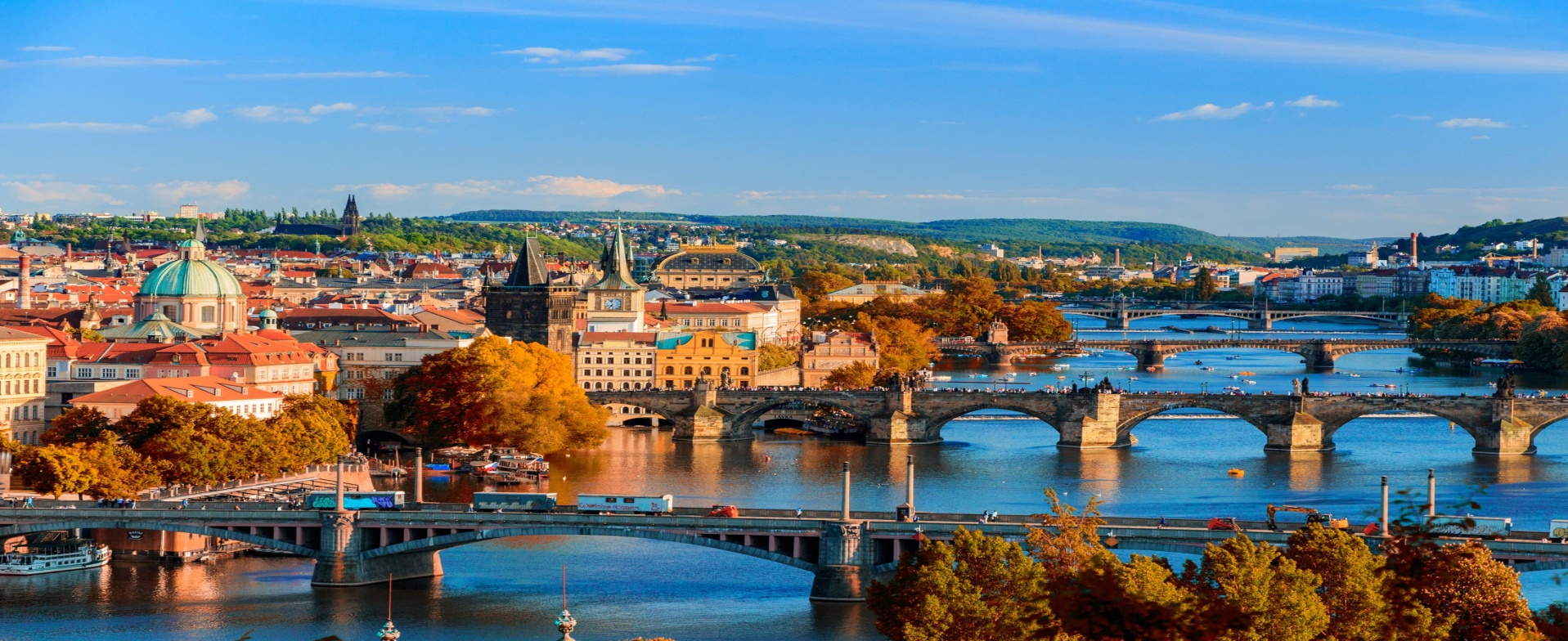
| Date of arrival: | optional |
| Date of departure: | optional |
| Price/person | EUR 700 |
Accommodation
Accommodation includes 8 nights with bed and breakfast. Just for your pleasure, I’ve chosen hotels that are ideally situated. Some of them are right in the centre of Prague. On the other hand, Prague Castle is about a 10-minute walk from Hotel Loreta.
Guided Tours (by minibus with a guide)
Karlovy Vary + Moser Factory (8 hours)
Karlovy Vary is probably the best known spa town in the Czech Republic. Its history begins in the 14th century, at the time of the reign of Charles IV. The healing powers of the local springs have been tested by such illustrious people as the Russian Tsar, Peter the Great and the German poet, Goethe. Karlovy Vary also became famous thanks to the local manufacture of the world-renowned Moser crystal, Carlsbad porcelain and the herb liqueur, Becherovka. After arrival in Karlovy Vary, your group will visit the Moser factory and then be taken on a tour of the town centre by our guide to see the most famous Vřídlo (Sprudel) geyser – gushing its mineral water to a height of almost 12 metres. After lunch you are free to explore the town on your own.
Hluboká Castle + Červená Lhota Chateau (8 hours)
Hluboká Castle
On a rocky hill, 83 metres (272 ft.) above a bend in the Vltava, rises the massive bulk of Hluboká Castle, which once belonged to the Princes of Schwarzenberg. Originally built in the 13th century, it was much altered in later centuries. It was first enlarged during the Renaissance period, then rebuilt as a Baroque castle at the order of Adam Franz von Schwarzenberg at the beginning of the 18th century. It acquired its current appearance during the 19th century, when Johann Adolf II von Schwarzenberg ordered the reconstruction of the castle in the romantic style of England’s Windsor Castle, with 11 towers and several bastions. Hluboká is considered one of the most beautiful castles in the Czech Republic. It is also a National Cultural Monument. The Schwarzenbergs lived here until 1939, when they lost their property during World War II.
The Castle now is a museum, open to the public and displaying in its more than 140 rooms valuable collections of paintings, porcelain, glass, tapestries, furniture, hunting trophies, arms and much more. The mid-19th century riding school is now occupied by the Aleš Gallery (1952-55), named after the Czech painter Mikoláš Aleš (1852 – 1913), with a large collection of paintings and sculpture by Southern Bohemian artists from the Middle Ages (particularly the Gothic period) to the present day. A beautiful park, with a game reserve surrounds the Castle.
In the Castle grounds are also a winter garden and riding hall which has housed Southern Bohemian gallery exhibitions since 1956. The Castle offers several guided tours, during which one may admire the interiors of private rooms and lavish ceremonial halls. The interior walls and ceilings are richly decorated with wood carvings and panelled with valuable wood. Some rooms are decorated with paintings by European masters from the 16th to 18th centuries, chandeliers, stained glass and Delft ceramics – especially the bedroom and dressing room of Princess Eleonora, the reading room and Hamilton’s Cabinet. Portraits on the walls depict the most important members of the Schwarzenberg family. Visitors will also appreciate the Castle armoury and the kitchen, with 19th- and 20th-century appliances.
Červená Lhota Chateau
Červená Lhota (Red Lhota) is a Renaissance water chateau in the eastern part of South Bohemia. The Chateau and pond, park and some farm buildings were declared a National Cultural Monument of the Czech Republic in 2001. The Chateau is owned by the State (administrated by the National Monument Institute) and has been open to to the public since 1949. The first written mention dates from 1465, when Knight Jan Kába of Rybňany had the old Gothic fortress rebuilt into a more comfortable Renaissance chateau, called Nová Lhota (New Lhota). The name Red Lhota dates back to the beginning of the 17th century, named for the colour of the Chateau, according to a legend. Over the centuries, the Chateau has been owned by various aristocratic families, e.g. the Windischgrätzs and Schönburgs. The Chateau contains a fine collection of furniture. It was occupied for a time by 18th-century musician and composer, Karl Ditters von Dittersdorf.
A tour of the Chateau takes about 50 minutes, during which you can view 16 rooms, where aristocracy resided in the 19th and early 20th centuries. It is possible to hire a boat, take a cruise on the Chateau pond and view the park and Chateau from a different perspective. Červená Lhota is the third most visited castle in the South Bohemian Region (after Český Krumlov and Hluboká).
Kutná Hora – UNESCO-Listed (5 hours)
Kutná Hora, a medieval silver-mining centre, was once the second richest town in the Kingdom of Bohemia. The former wealth of the town is today reflected in the variety of architectural monuments and in the preserved structure of the town centre. The tour of Kutná Hora will not only take you to St. Barbara’s Cathedral, but also to many beautiful Gothic, Renaissance and Baroque townhouses and to visit a unique 15th-century stone fountain. You will also see one of the most interesting burial grounds in the world: the Sedlec Ossuary. This chapel is decorated with more than 40 000 human bones, arranged in a chandelier, the Schwarzenberg coat of arms, etc. Kutná Hora has been on the UNESCO List of Cultural Heritage Sites since 1995.
Transfers

- Transfer from the airport to the hotel.
- Transfer from the hotel to the airport.
Service for Tourists
 Our agency is situated right in the centre of Prague. We are at our clients’ disposal throughout their stay. We are able to assist clients with all the common and essential situations that arise, as well as with medical care, should that be necessary.
Our agency is situated right in the centre of Prague. We are at our clients’ disposal throughout their stay. We are able to assist clients with all the common and essential situations that arise, as well as with medical care, should that be necessary.
